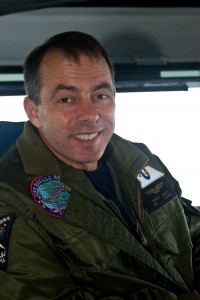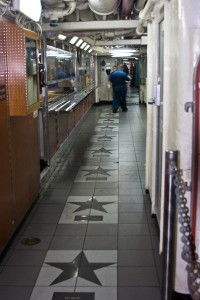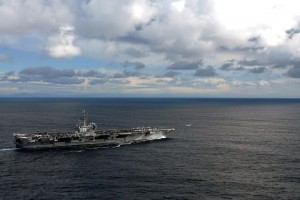
An F/A-18 Hornet launches from catapult 1 on the flight deck of the Nimitz-class nuclear-powered aircraft carrier USS Ronald Reagan (CVN-76) during flight operations.
By Bob Shane
By almost any measure, America’s newest Nimitz-class aircraft carrier, the USS Ronald Reagan (CVN-76), is the mightiest warship ever built. In 1994, Newport News Shipbuilding in Virginia won the contract to build the supercarrier; it took five years to construct, at a cost of $4.5 billion. Its keel was laid in 1998, and the ship’s commissioning and maiden voyage was in 2003.
The USS Ronald Reagan is the largest single weapon in the U.S. arsenal and the world’s biggest mobile combat airport. At 1,096 feet long, it’s nearly as long as the Empire State Building is tall. It stands 20 stories above the water and weighs 97,000 tons fully loaded; two nuclear reactors propel it through the water at better than 30 knots. The Reagan is home to almost 6,000 sailors, of which 20 percent are women. A floating American city, it even has its own zip code.

The Northrop-Grumman C-2 Greyhound, flown by Fleet Logistic Support Squadron 30 (VRC-30), the Providers, is used as a carrier onboard delivery aircraft, bringing cargo and passengers to the ship.
Its namesake, the 40th president of the United States, first coined the ship’s motto, “Peace through Strength.” It was a prevalent theme throughout the 1980s during Reagan’s tenure. Reagan was a staunch supporter of naval power; a key initiative of his presidency was a 600-ship Navy. He sought to rebuild America’s military after the cutbacks that followed the end of the Vietnam War, shrinking the number of U.S. ships from more than 1,000 to 453.
The Reagan is part of Carrier Strike Group Seven. The primary strength of any carrier strike group is its air wing. Carrier Air Wing Fourteen, aboard the Reagan, has a complement of more than 80 aircraft, when deployed, consisting of C-2A Greyhounds, E-2C Hawkeyes, SH-60F/H Seahawks, EA-6B Prowlers, F/A-18C Hornets and F/A-18E and F model Super Hornets.
A two-plane detachment of Grumman C-2A Greyhounds is generally assigned to the Reagan when it’s on deployment. The twin-engine cargo and passenger aircraft nicknamed the “COD”—carrier onboard delivery—provides logistical support for the Reagan.
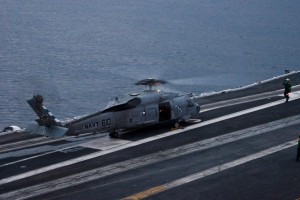
An SH-60F Seahawk helicopter of Helicopter Anti-Submarine Squadron 4 (HS-4), the Black Knights, prepares to launch prior to night flight operations.
Four Northrop Grumman E-2C Hawkeyes are assigned to the Reagan. The 250-mile search radar on the twin-engine, all-weather airborne early warning aircraft warns the carrier task force of any approaching enemy air threats and provides identification and position data to the F/A-18 fighter aircraft. It has the capability to locate and track 2000 targets.
The Reagan has six Sikorsky SH-60F/H twin-engine Seahawk helicopters assigned to it, for anti-submarine warfare and search and rescue operations. Four Grumman EA-6B Prowlers, electronic warfare platforms, have a primary mission of protecting the fleet’s surface ships and aircraft by jamming hostile radar and communications.
Four squadrons of F/A-18 Hornets are on board the Reagan. The twin-engine multi-mission tactical fighter jet is designed to attack both air and ground targets. Two of the squadrons are “C” models, while one consists of “E” model Super Hornets and one of “F” model Super Hornets. The Super Hornet is a significant upgrade from the original F/A-18.
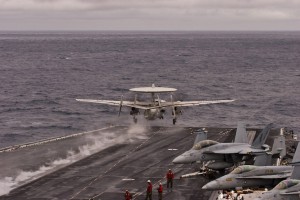
An E-2C Hawkeye aircraft of Carrier Airborne Command and Control Squadron 113 (VAW-113), the Black Eagles, launches from the number 2 catapult at the beginning of flight operations.
The Reagan embarked on its maiden deployment in 2006. It was a six-month cruise in support of the war on global terrorism. It made a three-month deployment to the Western Pacific in early 2007.
Recently, the ship completed a six-month planned incremental availability, which started in May 2007. During that period, the carrier received $150 million in renovations and upgrades, including the installation of an advanced recovery control system. The ARC is a new type of arresting gear, which uses state-of-the-art digital control system technology. It replaced the conventional mechanical system, making the Reagan the first carrier to computerize this basic function. The upgrade will reduce supply and maintenance needs, extend the life of the current arresting gear and raise the level of safety.
In its short operational life, the Reagan has already garnered the Battle Efficiency Award. Also known as the Battle “E,” it’s awarded each year to a small number of ships and Navy units that win their battle efficiency competition. It’s a measure of the ship’s readiness to carry out its assigned wartime task, and the Reagan has demonstrated the highest level of battle readiness.
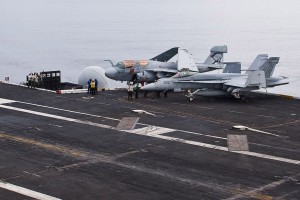
An EA-6B Prowler, flown by Electronic Attack Squadron 139 (VAQ-139), the Cougars, is parked next to an F/A-18C of Strike Fighter Squadron 113 (VFA-113). The EA-18G Growler, a variant of the F/A-18F, will replace the EA-6B in 2009.
The Navy takes great pride in its fleet of flagship aircraft carriers and loves to showcase them. It invites distinguished guests, community leaders and media groups to come aboard and view training exercises while the ship is at sea. This program increases citizen awareness and understanding of what the Navy does. These 24-hour “cruises to nowhere” are a rare opportunity to closely scrutinize naval aviation and carrier ops. Whether on the deck, viewing traps (arrested aircraft landings) and cat shots (catapult-assisted takeoffs) with an escort from the ship’s Graphics Media Department or from Vulture’s Row—an outside balcony platform on the top deck of the carrier’s island—observers are never far from the impressive action.
On November 27, the USS Ronald Reagan left its homeport of San Diego to complete a tailored ship’s training assessment. The TSTA is an intense training cruise designed to prepare the ship and its embarked air wing for sustained combat operations at sea. Numerous shipboard training exercises are conducted to test the ship’s damage control ability.
A unique experience: the first trap
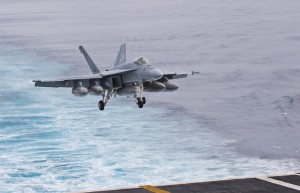
An F/A-18E Super Hornet refueler of Strike Fighter Squadron 115 (VFA-115), the Eagles, makes its landing approach to the flight deck during day operations.
On November 29, the Reagan cruised up and down the coast of Southern California and Mexico, approximately 100 miles from shore. At Naval Air Station North Island, located at the north end of Coronado Island in San Diego Bay, passengers were ready to embark. After arriving at the base—built in 1917 and granted official recognition as the “Birthplace of Naval Aviation” in 1963 by the U.S. House Armed Services Committee—passengers received a safety briefing.
After they were issued protective gear for the 35-minute flight to the carrier—life vest, goggles and cranial (a flight deck helmet with ear protection)—the passengers were loaded into a waiting C-2A Greyhound of the VRC-30 squadron. Known as “The Providers,” the squadron efficiently transports high-priority cargo, mail and passengers to and from Pacific Fleet aircraft carriers.
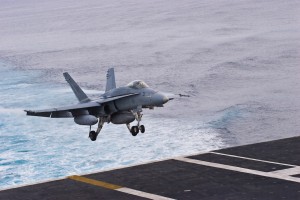
Strike Fighter Squadron 113 (VFA-113), the Stingers, fly the Boeing F/A-18C Hornet as part of Carrier Air Wing 14 (CVW-14).
Passengers were securely strapped into their rear-facing seats as the aircraft’s large aft door ramp closed. The cabin was dark; there was a noticeable lack of windows. For the passengers on the flight to the boat, the rare and unique experience of an arrested landing on an aircraft carrier was one that they weren’t able to see but definitely felt. Going from 140 mph to a dead stop in less than two seconds is a ride you won’t find in any amusement park. The only visual cue or warning that the aircraft was about to come to an abrupt stop was a member of the flight crew waving his arms just before the moment of impact.
For a pilot, landing on an aircraft carrier is the most difficult maneuver to learn. Trained Navy aviators regularly perform this task day and night, in all types of weather conditions and on a pitching and rolling deck. It’s much riskier than a takeoff.
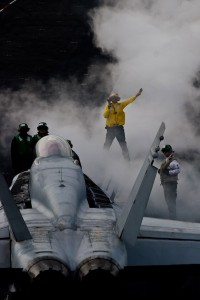
An aircraft handler directs an F/A-18C of Strike Fighter Squadron 25 (VFA-25), the Fists, into its launch position on the number one catapult during flight operations.
The aircraft enters the carrier landing pattern, rolls out behind the ship and lines up for what is typically a 15- to 20-second approach. The pilot uses an optical landing system, located on the port side of the flight deck, which involves centering an amber light called a “meatball.” He’s also in constant communication with a landing signal officer who’s controlling the approach and landing. The LSO, a fellow pilot, remains in position near the stern, on the port side of the ship.
The goal is to get the aircraft’s tailhook to snag one of three high-tensile steel arresting wires stretched across the deck, 50 feet apart. As soon as the plane hits the deck, the pilot advances the engines to full power in case a bolter (non-trap) occurs and a go-around becomes necessary. A bolter happens in only five to 10 percent of all first attempts to land.
The flight deck
Once you exit the C-2A Greyhound and step foot on the carrier’s flight deck, it takes only a nanosecond to realize you can easily be in harm’s way. A multitude of hazards are present, many that are life threatening.
When air operations are in full swing, squadron aircraft are
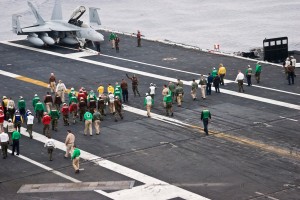
Flight deck personnel conduct a walk-down for foreign objects and debris that could damage an aircraft if ingested by the engines. Different colored jerseys distinguish various jobs on the flight deck.
taking off and landing simultaneously. Hornet and Super Hornet jet fighters are being cat shot into the air every 30 seconds, not far from where you’re standing.
A multitude of dangerous jobs is simultaneously performed in a relatively small area. Aircraft are brought up from the hangar deck on elevators, towed to various positions on the flight deck and chained down until flight time. While aircraft maintenance and fueling is going on, sailors are loading live missiles, bombs and ammunition on planes to prepare them for flight. Some aircraft taxi across the deck as the engines on others are spooled up to maximum power and afterburners are ignited. There is the ever-present danger of being blown overboard by a jet exhaust or run over by a moving aircraft.
The flight deck of an aircraft carrier is a challenging environment. The potent odor of JP-5 jet fuel strongly permeates the air. The noise level from roaring jet engines is so deafening that double ear protection is recommended.
“An aircraft carrier’s flight deck is a million accidents waiting to happen,” said George C. Wilson, the author of “Supercarrier.”
A mistake in this highly supercharged environment, where so much activity is going on in such close quarters, could result in a catastrophe, potentially having a ripple effect across the flight deck. Working under such demanding conditions requires a profound level of situation awareness at all times. The only acceptable standard is “Zero Defects.” There’s no margin for error. Execution of carrier landings and takeoffs must be perfect every time. This is why being a naval carrier pilot is an exacting profession and flight deck personnel responsible for working on and moving airplanes around the deck must remain vigilant and focused. In spite of the inherent danger in catapult launches and arrested landings, the Navy has a remarkable safety record.
To reduce risk and minimize the danger and hazards of the flight deck, the Navy places a great amount of emphasis on extensive aircrew training and high maintenance standards for its aircraft and equipment. This approach has made a high-risk operation fraught with danger appear routine.
Carrier air operations are commonly portrayed as a well-choreographed ballet. The script is a book of flight deck rules. All the elements of a top Broadway production are present: artistry, technique, flow, rhythm, training and speed.
The stage for this drama is a 4.5-acre flight deck. Just as ballet dancers float through the air defying the law of gravity, so do the Reagan’s squadrons of aircraft. The responsibility and role of each member of this aeronautical cast corresponds to the color of their jersey. The flight deck is a kaleidoscope of color as crewmembers prepare to launch and recover aircraft.
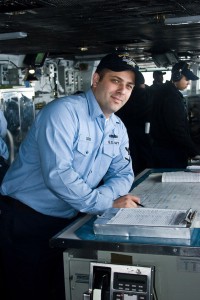
Quartermaster 3rd Class Lawrence Orso stands guard on the bridge of the USS Ronald Reagan. The quartermaster of the watch is responsible for the day-to-day navigation duties.
The yellow shirts are plane handlers. Using a series of intricate hand signals, because of the extremely high noise levels, they direct all moving aircraft. Wearing green shirts, air wing maintenance personnel and catapult and arresting gear crew hook the planes to the catapults and assist with recovery of aircraft from the flight deck. Brown shirts are plane captains. Blue shirts are the chalks and chains people, who secure airplanes and drive aircraft tugs. Red shirts are the weapons and ammunition crew. Purple shirts or “grapes” fuel aircraft. White shirts are safety observers and medical personnel. The silver suits are the fire and crash crew.
Just as professional ballet dancers practice daily to remain skilled, the flight deck cast performs daily drills. They have to be good because the lives of their comrades are in their hands. With 600 new sailors aboard the Reagan on this cruise, the training is particularly intense.
The carrier’s brain center
The Primary Flight Control command center is perched on the top of the carrier’s “island.” From here, the “air boss” and his assistant “mini boss” direct all activity on the flight deck and within a five-mile radius of the ship.
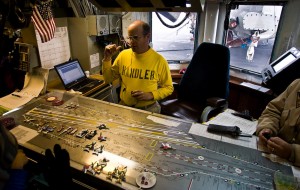
Lt. Derek Jensen, the aircraft handling officer, utilizes a scale model of the flight deck, commonly called the “Ouija board,” to coordinate placement and movement of aircraft.
The next level below Pri-Fly is the carrier’s “bridge.” Here, the Reagan’s commanding officer directs the helmsman steering the ship. This is also where you’ll find the “quartermaster of the watch,” who keeps track of the ships navigation.
Capt. Terry Kraft, the skipper of the Reagan, was born the son of a Navy captain. He graduated from the U.S. Naval Academy in 1981 and proceeded to NAS in Pensacola, Fla, earning the coveted naval flight officer wings of gold in 1982. He has 3,700 flight hours in the A-6 Intruder and the EA-6B Prowler. Kraft participated in combat operations against Libya in 1986, Desert Shield and Desert Storm in 1991, and Enduring Freedom and Iraqi Freedom in 2002 and 2004.
On Nov. 17, 2005, Kraft assumed command of the USS Ronald Reagan. From his imposing leather captain’s chair on the bridge, he carries out the awesome responsibility of managing a floating airport, hotel and nuclear power plant.
After a night of sailing through some rain and fog, mid-morning on Nov. 30, Kraft received a weather briefing, and then discussed his role as captain. Kraft comments that his is the best job in the world and that he’s fortunate to have “the very best 5000 sailors and 17 department heads in the Navy.”
Talking about the current training cruise, Kraft said inspectors were on board and that the crew had been doing many battle drills.
“It’s the first time the air wing has been on board since April 19,” he said. “We just completed pilot carrier qualifications in three days. You never know when you may be pressed into action. We need to prove we’re ready to deploy and go over the horizon.”
One thing that keeps morale high on the Reagan is the “Sailor of the Day” program, which recognizes outstanding performance. The sailor receives a certificate and the opportunity to sit in the captain’s chair. Kraft tells the winner, “It took me 25 years to be able to sit in that chair.”
All carrier COs are aviators, and Kraft has amassed more than 1,000 carrier landings.
“According to my wife, that just means I’m an old carrier pilot,” he quipped.
Low-tech tracking in a high-tech world
In the flight deck control and launch operations room, the Reagan’s “handler,” Lt. Derek Jensen, and his crew, keep track of all aircraft on the flight deck and in the hangar area. The tracking tool, known as the “Ouija board,” is a two-level transparent plastic table with an outline of the flight deck and hangar deck. Every plane on board the carrier has a miniature replica. When an actual aircraft moves, the handler manually moves its replica accordingly. Because of the many variables and changing conditions involved, computerizing the function still isn’t possible.
The maze below the flight deck

An F/A-18 aircraft touches down during a time exposure of night flight operations. The aircraft-arresting hook striking the steel flight deck causes the sparks.
Below the flight deck, quarters are extremely tight. Here too, maintaining situation awareness is necessary for survival. Very much an industrial environment, the ship is a maze of narrow and sometimes darkened passageways. There are low overheads, knee-knockers, exposed pipes and cables and numerous vertical stairways to climb. A sailor working below deck could go for weeks without ever seeing daylight.
The visitor’s staterooms are located on the carrier’s gallery deck, one level below the flight deck. These sleeping quarters occupy a position below the jet blast deflector on the #2 catapult. During night flight operations, which last until 1:00 am, you’ll wish you had kept your cranial with its ear protection. The noise level is incredible, and you can even view the F-18 and its engines being advanced to full power, right above your head, on an in-room TV. Thankfully, the engineers who designed the Reagan didn’t believe in soundproofing and noise abatement. Overnight guests are able to experience the real sound of freedom.
The Reagan claims to serve the best food in the Navy, and the ship has a trophy to prove it. Its five mess halls serve 18,000 meals a day. In a nod to Reagan’s movie career, one mess hall has its own Hollywood Walk of Fame, with names such as Frank Sinatra and Arnold Schwarzenegger.
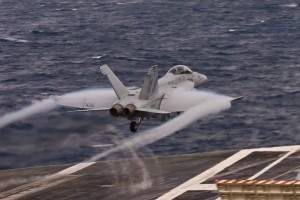
An F/A-18E Super Hornet of Strike Fighter Squadron 22 (VFA-22), the Fighting Redcocks, exhibits some condensation during a launch from the waist catapult.
It’s a Navy tradition that a ship honors its namesake. On board the carrier is the Ronald Reagan Room, which contains memorabilia of the former president, including a piece of the Berlin Wall. In the various dining areas of the ship, an abundance of photography chronicles Reagan’s accomplishments. Framed photos and movie posters covering his time in Hollywood decorate the crew’s mess. The wardrooms display photos from his two terms as the governor of California. The chief petty officers’ dining area contains photos of Reagan on his ranch in Santa Barbara, and pictures from Reagan’s tenure in the White House are displayed in the admiral’s and captain’s dining room.
An exhilarating experience
After the tour, it’s time to board the C-2A Greyhound for the cat launch and return flight back to NAS North Island.
The Reagan has four steam-powered catapults that routinely propel fully loaded, 67,000 pound F/A-18 aircraft from zero to 165 miles per hour in a mere two seconds. One would have to drive a top fuel dragster to experience that kind of acceleration. The catapult shot off the deck of an aircraft carrier—like being shot out of a cannon—is one of aviation’s more exhilarating experiences.
Overall, this tour was incredibly enlightening, providing an insight into what’s involved in the preservation of freedom that will not soon fade. It’s reassuring to know that the USS Ronald Reagan is out there, on guard, patrolling the oceans of the world.












